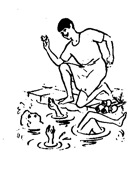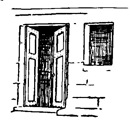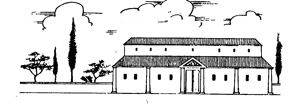Part A. Quaestiōnēs dē exercitiīs et textū.
1. Rewrite these sentences changing subjects and verbs from singular to plural:
a) Dominus multōs servōs salūtat. _____________ multōs servōs _____________.
b) Fīlia plōrat. ______________ __________________.
c) Familia in parvā vīllā habitat. _____________ in parvā vīllā _____________.
d) Vir rosās ex aquā sūmit. ___________ rosās ex aquā _____________.
e) Oppidum in īnsulā est. ____________ in īnsulā __________
2. Rewrite these sentences making the direct object the opposite in number (if singular, make it plural; if plural, make it singular):
a) Cubiculum fenestram habet. Cubiculum ______________ habet.
b) Iūlius habet servōs. Iūlius habet _________________.
c) Syra līlium carpit. Syra _____________ carpit.
d) Liber capitula habet. Liber ____________ habet.
e) Puerī fluvium vident. Puerī __________ videt.
3. In these sentences add the correct form of the ablative ending:
a) Multae rosae sunt in parv_____ hort_____.
b) Iūlius et Aemilia habitant cum mult_____ serv______ et ancill______.
c) Baculum et sacculus sunt in mēns______ .
d) Iūlia cum ūn_____ ros______ discēdit.
e) Sunt multae prōvinciae in Imperi______ Rōmān______ est.
4. In these sentences you will see the one of the forms of the nouns hortus, īnsula or baculum. In the blank space of the repeated sentence insert the personal pronoun is, ea, id with the same gender, number and case as the one of these three nouns it replaces.
a) Hortus multās rosās nōn habet. _________ multās rosās nōn habet.
b) Familia īnsulam videt. Familia __________ videt.
c) Iūlius discēdit sine baculō. Iūlius discēdit sine _________.
d) Rosae et līlia in hortō pulchra sunt. Rosae et līlia in ______ pulchra sunt.
e) Fluviī īnsulae magnī sunt. Fluviī _________ magnī sunt.
f) Iūlius habet hortum in peristylō villae suae. Iūlius habet ______ in peristylō villae suae.
g) Baculum est in mēnsā. _______ est in mēnsā.
h) Īnsulae sunt in Oceanō Atlanticō. ________ sunt in Oceanō Atlanticō.
i) Numerus hortōrum in Italiā magnus est. Numerus __________ in Italiā magnus est.
j) Ab insulīs veniunt multī servī. Ab ________ veniunt multī servī.
5. Decide whether the sentence calls for an imperative or an indicative form of the verb, whether it should be singular or plural, and what the conjugation of the verb stem is, then insert the correct ending:
a) Aemilia voc_____ līberōs suōs: "Ven_____, Mārce et Quīnte Iūliaque!"
b) Iūlia ven_____, sed Mārcus et Quīntus Aemiliam nōn aud_______.
c) Iī sunt in ātriō, ubi Mārcus rīd____ et Quīntus plor_______.
d) Aemilia Iūliam interrogat: "Quid meī fīliī ag______?"
e) Iūlia nōn respond______.
f) Dēlia et Syra ven_______, et Aemilia imperat: "Ag______, meae ancillae, et interrog_____ meōs fīlios, quī sunt in ātriō."
g) Syra (in ātriō): "Ō Mārce, cūr est Quīntus in impluviō ubi is aquam puls_____?"
h) Mārcus: "Ō foeda et antīqua ancilla cum magnō nāsō, discēd____ ab mē!"
i) Syra et Dēlia ab Mārcō discēd________,
j) Aemilia (īrātus): "Meus fīlius Mārcus improbus est. Is mē nōn dēlect_____. Ō, ubi est Iūlius?"
6. Circle the mistaken word in these sentences and write the correct form of the word in the space provided:
a) In hortō sunt multae rosās. ________________
b) Puerī cantat et rīdent. ________________
c) Iūlius ūnum nummus in sacculō Dāvī pōnit. _________________
d) Iūlius habet centum servus. _______________
e) Sunt multī īnsulae in Graeciā. _________________
f) Dāvus sacculum suum sūmunt. _____________
g) Syra fēmina pulchram nōn est. ______________
h) In vīllā Iūliī sunt duo ōstium et multae fenestrae. ________________
i) Fīliae bonōrum servōrum quoque habent laetās familiīs. _______________
j) Aemilia īrātus est. ____________
Part B. Reading Comprehension – Read this passage and answer the questions which follow based on the information in it. Put the letter of the correct answer in the blank space.
In oppidō Tūsculō magnum forum est. In forō est templum antīquum. Iūlius in forō est cum quattuor servīs, neque Mēdus in iīs est. Ubi est Mēdus? Mēdus quoque in oppidō Tusculō est, neque is in forō est cum dominō, sed sine dominō in templō. Mēdus sōlus est in magnō templō vacuō. Quid agit servis Iūliī in templō? Nummōs numerat.
Mēdus: "quot nummī sunt in sacculō meō. Ūnus, duō, trēs, quattuor, quīnque, sex, septem, octō, novem, decem. . . . nōnāgintā. Ecce nōnāgintā nummī. magna pecūnia mea est.!"
". . . mea est!" respondet templum vacuum.
Mēdus: "Quid? Num dominus adest?"
". . . adest" respondet templum vacuum.
Sed sōlus est servus in templō. Nūllus dominus verba eius audit. Nōn in templō, sed in forō est Iūlius. Quid agit Iūlius in forō Tūsculānō. Dominus servum suum quaerit.
Iūlius imperat: "Quaere Mēdum, Dāve!"
Dāvus: "Ubi?"
Iūlius: "Quaere eum in templō!"
Dāvus ab Iūliō discēdit. Iam Dāvus in templō est et Mēdum quaerit. Dāvus Mēdum in templō videt.
Dāvus: "Ō Mēde. . .!"
Mēdus: "St, tacē, Dāve! Tacē et discēde!"
Dāvus: "Dominus in oppidō est et tē quaerit. Īrātus est dominus."
Mēdus: "Mēne quaerit dominus? Cūr mē quaerit?"
Dāvus: "Quia nummī eius in sacculō tuō sunt! Dominus pecūniam suam quaerit."
Mēdus: "Iūlius meus dominus iam nōn est. Neque nummī eius in sacculō meō sunt."
Dāvus: "Ō improbe serve!"
Mēdus: "Age, discēde, Dāve – et tacē! Improbus est servus quī servum accūsat."
Dāvus tacet, neque ab eō discēdit. Mēdus ex sacculō suō sūmit duōs nummōs.
Mēdus: "Ecce nummī tuī, probe serve!"
Dāvus: "Nōn meī sunt nummī, neque tuī, sed Īuliī sunt."
Dāvus nummōs nōn sūmit, et sōlus discēdit ex templō. In forō Iūlius Dāvum interrogat: "Estne Mēdus in templō?" Dāvus tacet.
Iūlius: "Respondē, Dāve! In templōne est servus meus?"
Dāvus respondet: "In templō est. . . servus tuus nūllus. (Mēdus servus tuus iam nōn est.)"
Iūlius, quī prīma tantum verba Dāvī audit, ex oppidō discēdit sine Mēdō. Mēdus sine dominō ex oppidō discēdit.
1. Where does the action in this story take place? ______ (a) Julius’ villa (b) on the road from Tusculum to Rome (c) in Tusculum (d) on the Via Appia
2. Who is with Julius? ______ (a) his wife and children (b) four slaves (c) Medus (d) Marcus, Quintus and Julia
3. A “Forum” in an ancient Roman town corresponds to what in the modern world? ________ (a) a public square (b) a stadium (c) an out-door theater (d) a cafeteria
4. Who is with Medus in the temple initially? ________ (a) his girlfriend (b) Davus (c) Syra (d) no one
5. How does Medus count his money? _______ (a) out loud (b) with an abacus (c) taking turns with his friend (d) incorrectly
6. What does he hear when he counts his money? _______ (a) Davus (b) Iūlius (c) his conscience (d) an echo
7. What is Julius doing in the forum? _______ (a) looking for a flower shop (b) waiting for court to start (c) getting Marcus and Quintus from school (d) hunting for his run-away slave
8. In line 14 “eum” refers to (a) Marcus (b) Medus (c) Aemilia (d) Davus
9. After Davus enters the temple and spots Medus he ________ (a) immediately goes out and notifies Julius (b) has a conversation with Medus (c) tries to get some of the coins (d) learns that Medus is a secret priest of this temple
10. Based on the text what would be the most probable way to explain why Davus did not betray Medus? ________ (a) Medus bribed him with two coins (b) Medus threatened to harm his family (c) There is some kind of unwritten code of conduct among slaves that they don't rat each other out (d) Medus was his brother-in-law
Part C. Translations - Say in Latin what these sentences say in English.
1. In the villa of Cornelius the mistress is calling the slave-women of the household. _________________________________________________________________
2. The slave-women do not hear her because they are sleeping in their bedrooms. _________________________________________________________________
3. The boy is also sleeping, and the man is away in the town with the other slaves. _________________________________________________________________
4. Now the woman is happy, because she is alone in the garden.
_________________________________________________________________
Part D. Free Response – Who are the persons and things in these pictures? Where are they? If something is happening, what is it? This is your opportunity to compose a description or statement about what you see here.


